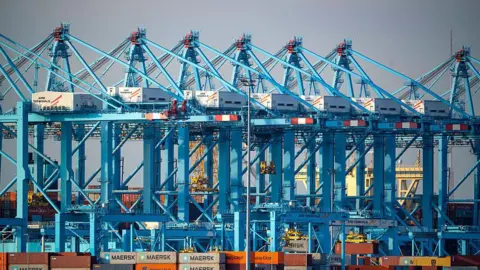The European Union (EU) has recently expressed optimism about reaching a trade deal with the United States, particularly as the 1 August deadline approaches. This deadline is critical because it coincides with President Donald Trump’s threat to impose a hefty 30% tariff on imports from the EU. The anticipated implementation of these tariffs has sparked concerns across Europe, prompting intense negotiations aimed at averting a potential trade war.
Recent signals from EU diplomats indicated that progress might be underway, as discussions revealed the U.S. is considering a broader 15% tariff on a wide range of European imports. This development was viewed positively by EU officials, who have been vigorously engaging in talks to broker a deal that benefits both consumers and businesses within Europe. Despite these discussions, a spokesperson for the European Commission refrained from giving specific insights on the state of negotiations, emphasizing that EU negotiators are working diligently to secure an agreement.
On the U.S. side, White House spokesman Kush Desai has advised that any dialogues about possible deals should be viewed as mere speculation unless officially confirmed by President Trump himself. This cautious rhetoric underscores the precarious nature of trade discussions between the two economic giants.
President Trump, in recent comments, laid out conditions under which he would retract his tariff threats. He indicated that the U.S. would reconsider imposing the 30% tariff if EU representatives agreed to open European markets more widely to American businesses. This call for reciprocation highlights the transactional nature of the negotiations and the critical importance of market access in securing an accord.
Concurrently, U.S. Treasury Secretary Scott Bessent expressed faith that the EU is making considerable strides toward a resolution. The importance of these negotiations cannot be overstated, as both sides seek to structure a mutually beneficial trade framework that minimizes disruptions to international markets.
The situation is further complicated by reactions from the European Central Bank (ECB), which chose to maintain interest rates at 2%. ECB President Christine Lagarde has articulated the need for swift action to resolve trade uncertainties, underscoring the direct impact these tariff discussions have on economic stability.
Prominent figures in the business community, including Bernard Arnault, CEO of French luxury conglomerate LVMH, have voiced their concerns over the potential fallout from an escalating trade conflict. Arnault emphasized the necessity of reaching an amicable agreement, highlighting the potential risks posed to European companies that engage heavily with the U.S. market.
The EU’s initial optimism for a lower baseline tariff rate of 10% between the U.S. and EU has been dampened by Trump’s escalating demands. The threat of substantial tariffs could impose serious burdens on European exports, raising concerns among businesses about their competitiveness and market access.
Despite the looming threat of U.S. tariffs, the EU has held back from implementing countermeasures thus far. Nevertheless, policymakers have specified a robust response plan that involves counteractions against U.S. goods amounting to €93 billion. These countermeasures, articulated by spokesperson Olof Gill, could become active just days after the U.S. tariffs, suggesting a readiness to respond firmly should negotiations fail.
This dual approach, while focused on achieving a negotiated solution, demonstrates that the EU is preparing for all potential outcomes. The planned countermeasures include a diverse array of targeted U.S. products, indicating the EU’s commitment to leverage significant economic pressure if necessary.
The scope of the proposed countermeasures encompasses an initial €21 billion in response to previous tariffs levied on European steel and aluminum and a new list amounting to €72 billion targeting diverse sectors. These could notably affect high-profile American exports including motorcycles, poultry, and automobiles, indicating the far-reaching implications of the tariffs on both sides. The EU has also put forth more drastic measures, such as restricting services and intellectual property rights, should the need arise.
As the clock ticks down to the 1 August deadline, the EU is prioritizing diplomatic negotiations while simultaneously preparing for an assertive response if those discussions do not yield favorable results. The urgency of reaching a resolution underscores the interconnected nature of the global economy in which both the U.S. and EU are deeply embedded.












